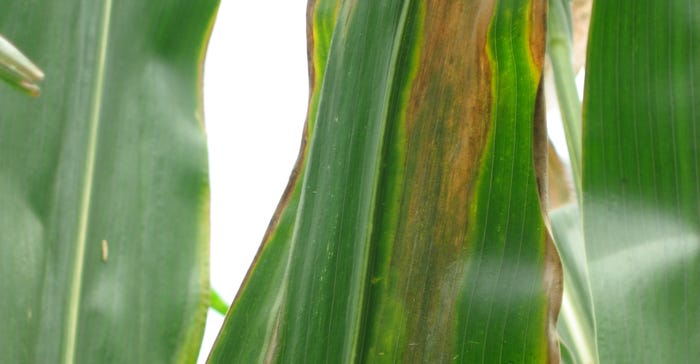July 22, 2020

As I am writing this article in mid-July, we have seen very little corn disease pressure in the western two-thirds of the state. Tar spot was first found in eastern Iowa the week of July 13 and in central Iowa later that same week.
Bacterial leaf streak has been found mostly in fields in eastern Iowa with higher rainfall compared to other parts of the state, but there are also scattered reports in other locations. There is a little gray leaf spot and northern corn leaf blight showing up, and fungicide applications, warranted or not, started the week of July 13 to 20.
Big 5 in Iowa
The five top corn leaf diseases in Iowa, in no particular order, are bacterial leaf streak, northern corn leaf blight, gray leaf spot, tar spot and southern rust:
Bacterial leaf streak. The disease is fairly new to Iowa but has been making a frequent appearance, especially in areas where with heavy precipitation. This disease is identified by narrow streaks found on and between the veins that are brown to orange and have wavy edges. This disease is often confused with gray leaf spot. But when bacterial leaf streak lesions on leaves are held up to the sun, you will notice bright yellow streaks extending from the lesions. Bacterial leaf streak is caused by bacteria, so fungicides are not effective against this disease. Hybrid selection and crop residue management are your best defense against this disease.
Northern corn leaf blight, gray leaf spot, tar spot and southern rust are all caused by fungal pathogens; therefore, fungicides are effective against these diseases. However, your best bet for management is hybrid selection.
Northern corn leaf blight. The lesions are characterized by 1- to 6-inch long ellipses that are grayish-green and turn tan or brown. The elliptical lesion is wider in the center than the ends. If you plant a resistant corn hybrid, lesions will be smaller and lighter colored.
Gray leaf spot. The disease is identified by rectangular lesions that are confined by the leaf veins. The lesions may start as a tan color, but weather to a gray color. The lesions can be up to 2 inches long. This disease always starts in the lower canopy about two to three weeks before tasseling.
Tar spot. A relatively new corn disease, it was first confirmed in Iowa in 2016. Tar spot is identified with small, dark, raised bumps across upper and lower leaf surfaces. The bumps may be circular or irregular, and often have “tails.”
Southern rust. The disease appears as small, round orange spots clustered across the leaf surface. Unlike the fungi that cause northern corn leaf blight, gray leaf spot and tar spot, the fungus that causes southern rust does not survive Midwest winters. This pathogen is carried by the wind each year into Iowa.
The contenders
Also found in Iowa on a regular basis are common rust, physoderma brown spot and Goss’s wilt:
Common rust. This disease can be found nearly every year someplace in Iowa but rarely is severe enough to cause concern. It is characterized by rusty-brown pustules. As the spores age, they turn black and are sometimes confused for tar spot.
Physoderma brown spot. This fungal pathogen causes very small lesions that are round to oval in nature and yellow to brown in color, and appear in bands across the leaf. Dark purple, round spots are also present on the midrib and may also occur on the leaf sheaths.
Goss’s wilt. Most corn hybrids grown today have very good resistance against Goss’s wilt. This disease is recognized as large long lesions that usually start at the tip or margin of leaves, appear water-soaked, have wavy edges and contain “freckles” within the lesions. This is a bacterial disease, so fungicides are not effective against this disease.
Now what?
August is usually too late for fungicide applications, so why should anyone worry about corn leaf diseases in August?
First, we want to make sure we have correctly identified the disease or diseases of concern. A fungicide application on a bacterial disease is a waste of money and time. Also, knowing the history of disease in a field will help you choose a well-suited hybrid for that field in subsequent years.
Second, we should evaluate the effectiveness of our fungicide application. Fungicide effectiveness at most will last two to three weeks, although some of the newer products may last twice as long. We should evaluate those applications to see how well that fungicide protected the ear leaf and canopy above.
Third, we want to evaluate our hybrid disease tolerance or resistance, or lack of tolerance or resistance. This will help us make corn hybrid decisions for the next year, particularly in corn-on-corn fields. Did your hybrid not tolerate disease pressure as you anticipated based on disease ratings? This may warrant a conversation with your seed dealer. And while August may be too early, we do anticipate an early harvest this year due to early planting and above-average growing temperatures, so start planning now on how best to prioritize those fields for harvest.
One thing to consider this year is stalk quality, especially in the dry parts of the state. Is stalk quality due to disease or due to stalk cannibalization from extreme moisture stress and nutrient reallocation? As we plan for next year, a useful resource is Fungicide Efficacy for Control of Corn Diseases by the Crop Protection Network.
Rieck-Hinz is the ISU Extension field agronomist covering north central Iowa. Contact her at [email protected].
About the Author(s)
You May Also Like






